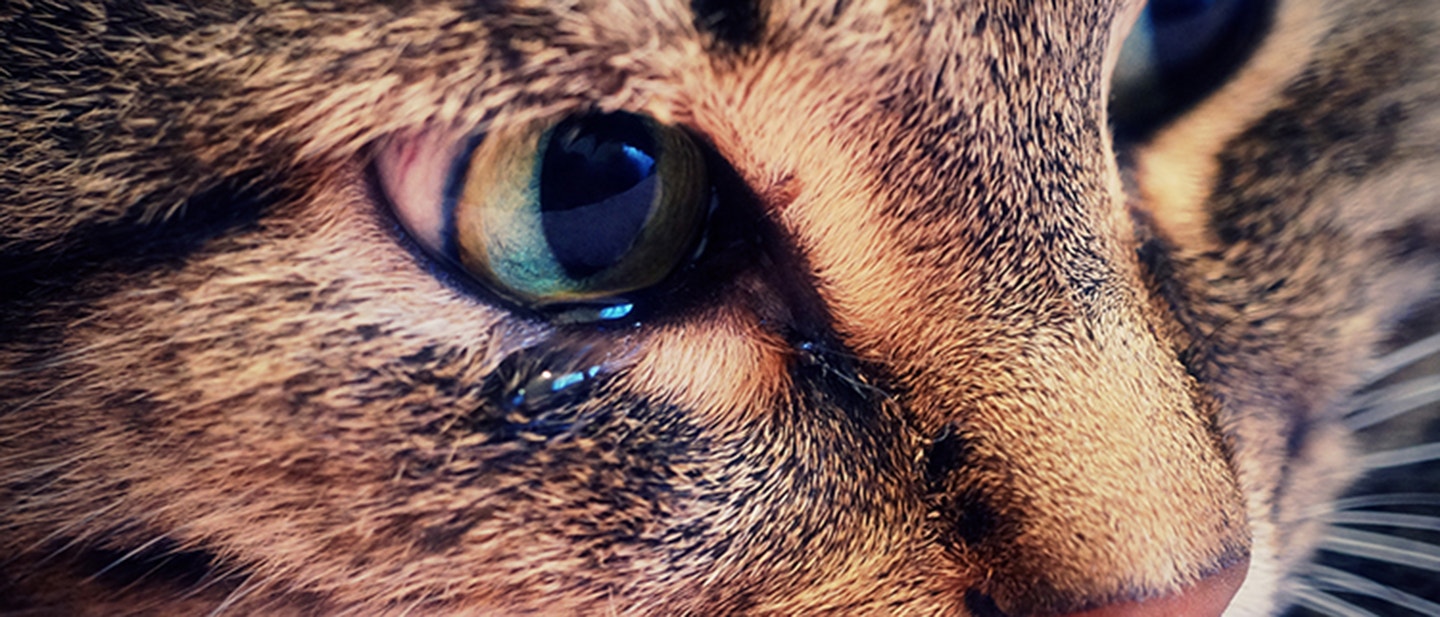
HOW TO STOP A CAT CRYING

Article checked by a vet
This is especially important in case your cat is trying to communicate stress or discomfort, so you can work out the cause and resolve the issue.
Something you may have come across online with the countless memes circulating, is a crying cat. However, what we perceive to be a cry is actually a normal cat vocalisation to see where you are or to get your attention, since cats don’t cry with tears. It’s also normal for kittens to cry when left alone, as they may be vocal if they’re not yet familiar with their new environment. Cats may also cry at night, making noise to get your attention, or if they are feeling hungry or lonely.
If their basic needs are already met but your cat’s eyes are watering, there could be an underlying health issue causing discomfort, which would necessitate a trip to the vet. In this article, we discuss common cat communication methods, along with the behaviour of a cat crying, why they do it and how to manage it. By interpreting your cat’s verbal cues and body language and responding appropriately, you can better understand your cat for a lasting and fulfilling relationship.
- Vocalisations. Some of the regular cat sounds we hear include meows, purrs, yowls and cat crying. Depending on the pitch and length of the meow, cats may be seeking attention, communicating hunger or simply greeting their humans. Purring is often a sign your cat is feeling content, although they may also purr to self-soothe when stressed or in pain. Yowling is often a drawn-out sound, often heard at night from the street, when unneutered or unspayed cats are attracting mates, or to signal discomfort or distress over territorial disputes. Cat crying, on the other hand, is high in pitch with a sense of urgency. If your cat is crying at night, they may be afraid, uncomfortable or simply getting used to being left alone.
- Reactive behaviours. There are some behaviours that cats can’t control, as it’s an immediate response to a trigger. For instance, if a cat feels cornered or defensive, they may arch their back and raise their fur to make themselves look bigger. They may also growl or hiss to communicate their aggression. Another example of reactive behaviour would be a cat gagging to expel a hairball or vomit something unpleasant that they’ve eaten.
- Physical responses. You can also understand a cat’s sentiments by observing their physical health. A cat with diarrhoea may have dietary issues or an infection. Cats who excessively groom themselves due to stress, skin conditions or allergies may have loss of fur or diarrhoea.
Cats that are allowed outside are exposed to more environmental factors that could affect them and make them cry. However, even changes within the home can trigger cats.
You may assume a cat is crying when their eyes are watery, but this is not the case. Watery eyes are usually caused by a range of other medical issues. We discuss these in more detail below:
Eye infections
If your cat has an eye infection, they may experience excessive discharge or tearing. Eye infections can be bacterial, viral or fungal, and present other symptoms such as redness and swelling. You’ll need to make a vet appointment for appropriate treatment.
Conjunctivitis
Cats can also experience this common eye condition, also known as pinkeye. This is when the membrane of the eyelid becomes inflamed, causing redness, swelling and discharge. You’ll need to make a vet appointment for appropriate treatment.
Corneal scratches or eye ulcers
It can look like your cat is crying if they have a corneal scratch or eye ulcer, and the surface of their eye is damaged. Outdoor cats can be at higher risk of this, especially if they are engaging in fights. You’ll need to make a vet appointment for appropriate treatment.
Allergies
Like humans, cats can also develop allergies to environmental factors, including pollen, dust, mould or chemicals. Allergies can look like a crying cat, but the cat is not crying. Their eyes are probably itchy and watery due to an allergic reaction. You’ll need to make a vet appointment for appropriate treatment.
Dry eyes or abnormal tear production
Some cats may be prone to dry eyes, or may produce an abnormal amount of tears. Both of these conditions can cause discomfort and irritation to your cat’s eyes. You’ll need to make a vet appointment for appropriate treatment.
Other illnesses
There are various other illnesses that may lead to noises that could sound like a cat crying, including respiratory illnesses like the cat flu, or systemic illnesses like feline herpesvirus. You’ll need to make a vet appointment for appropriate treatment.
It’s important to remember that a crying kitten or cat does not mean they are sad. Rather, it’s usually a physical response to something in their environment that is causing discomfort or distress, or most likely they are requesting food or attention.
Managing and preventing crying cats
If your cat is crying due to a health or environmental issue, there are steps you can take to address the underlying cause:
- Observe changes in your cat’s behaviour, including signs of discomfort.
- Consider any changes in their environment, including products used.
- Reduce their discomfort by removing any potential or common irritants.
- Keep their living space clean by hoovering regularly and washing bedding.
- Take your cat to the veterinarian for investigation and treatment.
You should not ignore, scold or punish a crying kitten or cat, as this can have a lasting effect on their behaviour and well-being. It’s also important to consider if you have an Oriental breed, that they are known for being highly vocal. Their noises can sometimes be interpreted as ‘cries’ when they are actually happy, and simply communicating with their family to receive attention.
It’s also possible that a crying kitten is simply adjusting to their new home and routine. If you want to stop a kitten crying at night, it can help to offer plenty of love and affection to soothe their anxiety, as well as keeping them close in the first few weeks.
Other signs of distress
While other behaviours are more common, such as not eating, overeating or yowling, a cat crying is another way for them to communicate distress to their owners. However, this is not the same as the human behaviour of crying with tears, but rather crying through vocalisations. It may sound like an elongated yowl or a desperate meow.
It’s normal for cats to experience distress when there are changes in their environment. This could be if you’re welcoming a new cat, family member or other pet to the home. Other factors that can be stressful include loud noises or unfamiliar scents. Cat parents can perform some checks, such as making sure their food and water bowls are in the same place, and that their litter tray is clean.
If you’ve recently brought home a kitten, they could be crying when left alone as they’re in a new environment. In this case, our new kitten checklist is helpful to prepare for the arrival of your feline friend. You could also consider if your cat is crying at night because they’re lonely, or if they’re bored. If it’s the latter, decide on the pros and cons of letting your cat outside or keeping them inside.
If your kitten or cat is still crying or showing other signs of distress, consult a veterinarian to perform health checks and diagnose the potential issue.
Crying Cat Memes
As a cat parent or enthusiast, you may have come across some cat crying memes online. While this has become a funny image in popular culture, we’re here to discern the distinction between factual information and entertaining content.
In these memes, the cats appear as though they are crying, creating a false revelation that felines actually produce tears when upset. However, these images are actually photoshopped or taken out of context for humorous effects, and are not reflective of a cat’s behaviour.
In fact, as we have discussed, a crying cat makes noises not tears, and can indicate a health issue. This is why it’s important to not misunderstand the behaviour. Cats need regular care and attention, as well as a high-quality diet with options like Perfect Fit™ Dry Food providing essential nutrition. Cats and kittens should also have regular health checks to detect any underlying issues early.
Conclusion
There are various ways to manage your cat’s crying behaviour, including if your kitten is crying when left alone or your cat is crying at night, with care and patience. If you’re concerned about your cat’s lifestyle, you can check out the debate on letting your cat outside vs. keeping them inside and see what works best for you and your feline friend.
